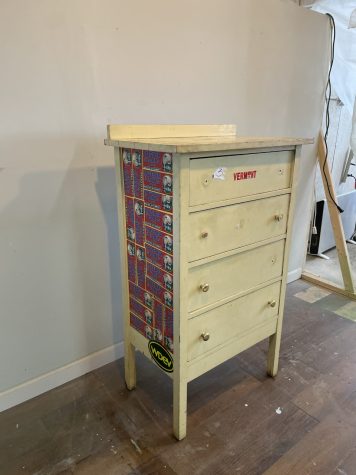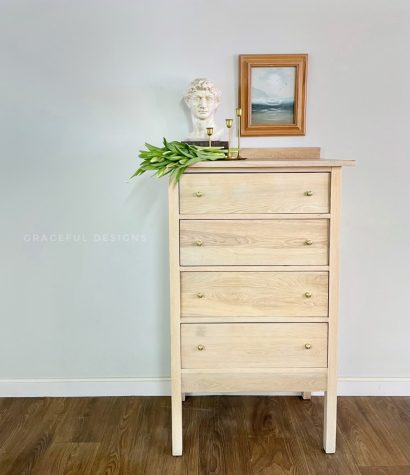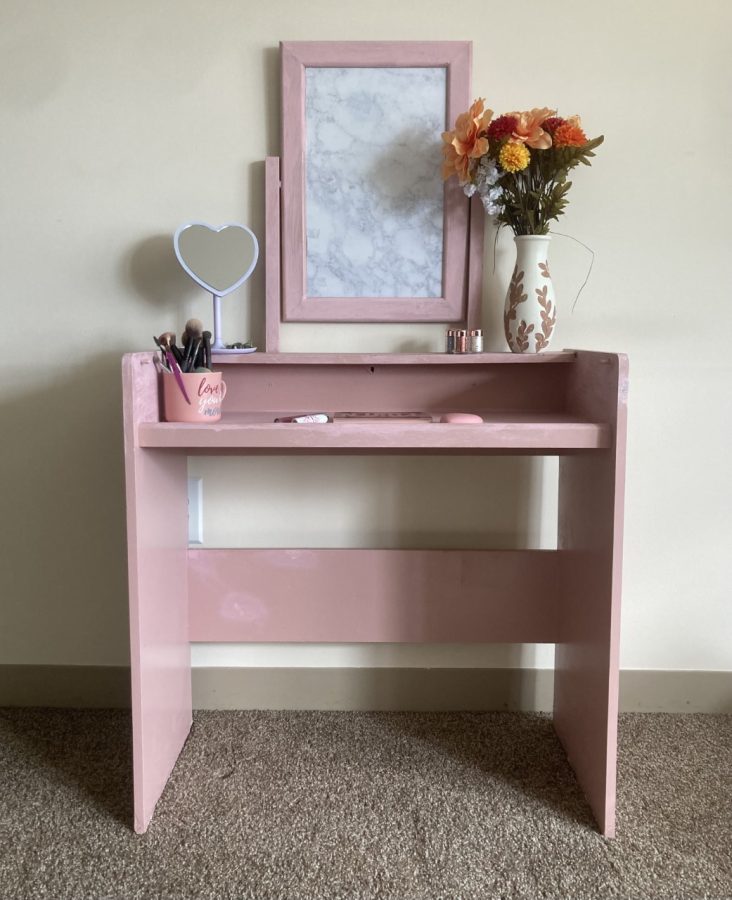Fabulously fun furniture flipping
1986- Wiscasset, Maine. My mother, a beautiful redhead, primps herself at her dark wood vanity. It’s a simple structure, no drawers or adornments, with a glass top over the veneer. She applies her rosy blush and brushes on mascara to frame her icy eyes, which match the blankets of snow and sleet outside.
The vanity was purchased by her mother. It was by no means an investment piece, just what was affordable and fit inside of the cramped bedroom. It was enough to get the job done.
2005 – Davenport, Florida. Just seven years old, I come running down the hallway into my mother’s room. I beg for Harry, the stuffed spider toy. For a little girl so scared of bugs, this toy was a surprising favorite of mine. My mother grabs him from the dark wooden vanity, which now acts as a display piece in the front of the master bedroom.
The veneer is peeling on the edges, revealing the particleboard interior. The mirror at the top is peeling from the back, rendering it useless as an actual vanity. Despite the damage, it is a sentimental piece to my mother.
2021- Burlington, Vermont. The once-dark veneer has been slathered in bubblegum pink paint, and the out-of-order mirror has been covered with marble contact paper to disguise the flaws. Despite the edges still peeling, the vanity is on proud display in my apartment as a reminder of my childhood.
Even though the vanity was a cheap thing that couldn’t even function as intended, the thought of sending it to a landfill hurt my soul. Instead of searching for a fun display piece that would add a pop of color to my funky living room, I decided to use what I already had, which saved me money and saved the environment from another piece of furniture going to waste.
The art of flipping furniture has been booming across the world in recent years, allowing people to breathe new life into older pieces, which may hold sentiment or have gorgeous details that new pieces simply lack.
Grace Elletson moved to Vermont in 2019 for a reporting job but found difficulty in making ends meet. “I was looking for a few extra hundred dollars to kind of stay afloat at the end of the month,” says Elletson. “I was also looking to pick up a creative skill and was seeing all of these beautiful pieces of art on my social media and thought, yeah, this might be what I’m looking for.”
Although she loves her side gig, Elletson doesn’t believe she will pursue it as a full-time career. Despite the creative freedom and flexible hours it offers, self-employment also requires some sacrifices, and she loves her current job as a reporter for an online publication. “I think there are risks to self-employment that I’m not sure I want to take on,” she says. “I do love my full-time job as it is right now.”
Elletson’s furniture finishing hobby-turned-part-time-job began in fall 2019, and her TikTok account currently boasts over half a million followers. “Unfortunately, in the USA, we only want to learn things in 30 to 60 second intervals,” says Elletson. “Because of those limitations, you have to communicate so effectively and strategically.”
“Once I started putting that content out there, people saw my social media pages as places where they can go and gain value,” continued Elletson. “And so that’s how I think the following really started rolling in.”
Elletson uses her influence as an opportunity to teach people who are interested in furniture refinishing. TikTok brings such a wide audience to her account, from teenagers who are still discovering new hobbies, to older individuals who have always had a passion for different forms of carpentry.


“I find that women, specifically women furniture refinishers, are so gracious and so helpful,” says Elletson. “A lot of men in woodworking are so ‘gatekeepy.’” With every post that goes viral, Elletson’s comment section is flooded with angry viewers that berate her for painting over antiques.
“Paint can always be removed,” says Elletson. “The art of painting a piece of furniture saves it from the dump, so there’re benefits to it. I very much am someone who will encourage people to design in whatever way brings them joy.”
Not every piece, however, is an eligible candidate for a simple refinish that maintains the natural finish. Sometimes, the wood is damaged beyond repair, and a complete makeover is needed. This can be in the form of painting, replacing wood or veneer, or even hacking the piece into something totally different.
Elletson’s favorite projects to work on are vanities that she splits into two matching side tables. “Today’s women aren’t really sitting at a vanity anymore and doing their makeup like they used to,” she says. “A lot of these vintage and antique vanities, just over time, are falling apart or fallen into disrepair. So, I take ones that have fallen apart, chop it, and make it into two more functional pieces that make a room so much more unique than any modern nightstand thayou can buy at Ashley Furniture.”
Furniture can be more than just a table or a dresser; it can be functional art. The type of furniture with which one fills their space sets the tone for the rest of their home.
“If you’re looking to put in the patience and the effort, you can curate a home that is more sustainable, and so much more unique, if you work with artists or do it yourself,” says Elletson.
Some furniture flippers even take the task beyond a fresh coat of paint and turn the furniture into something unique. Chicago-based artist Jenny Hiser uses bright colors and graffiti-inspired designs to breathe new life into her pieces with spray paint, acrylic, and even 3-D elements.
Popular video topics floating around DIY TikTok and YouTube are Ikea hacks, in which the creator teaches the audience how to personalize and upcycle basic and cheap Ikea pieces to better fit their home and to look more expensive.
Some popular YouTube content creators who have done these tutorials include “The Sorry Girls” and “Lone Fox.” Their innovative ideas allow people with smaller budgets to still make their homes look chic and put-together. The tutorials are also customizable in color and style, so anyone can make it fit their aesthetic.
Many furniture flippers find their hidden gems on Facebook Marketplace and at thrift stores, and some even turn back to Facebook Marketplace to resell their work. Elletson prefers to let her customers come to her.
“I primarily sell through my Instagram these days just because I’ve been so lucky to have grown an audience there,” says Elletson. She used to use sites like Craigslist and Facebook before her following grew. “But now people just, as I’m working on things in my stories, will say hey, is this available? And I kind of start a first dibs list.”
Typical turnaround for Elletson is about 20 to 30 hours of work, which she finds in her free time after her day job. She used to sell her pieces for under $200, but as her skills have advanced, she has been able to identify their real value.
“I also have a great privilege of not having to jack up my prices so high that they become unattainable and unaffordable for a lot of people who would typically buy from me,” she says. “I do it as a hobby, and I do it as a way to teach other people.”
However, pursuing furniture-flipping full time is definitely possible with the right tools, skills, and perseverance. A quality piece of redone furniture can sell for at least $1000, and the career is lucrative if done properly. Best of all, upcycling has a major positive impact on the environment by not adding to landfills and slowing down the need for production in factories.
Even though my skills as a furniture flipper may not be on the same professional level as Elletson’s, I am thrilled that I was able to save my mother’s childhood vanity from destruction. Also, as my style changes over the years, I can always strip the paint and start from scratch to keep this piece with me as long as I can. The sentimental piece of furniture will follow me wherever I go.

First year student from Orlando, FL.
Working on her second bachelors.
Love poetry, anime, and her dog (mostly her dog).
Dreams of living in a van.






